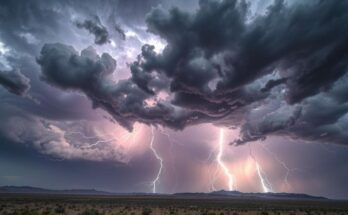A total lunar eclipse, coinciding with Holi on March 14, 2025, will create a “Blood Moon” viewable mainly in North America. The eclipse’s maximum phase will occur at 2:59 a.m. EDT. Various online platforms will offer free livestream options for viewing, as the phenomenon will not be visible in India due to timing.
On March 14, 2025, a total lunar eclipse will align with the Holi festivities, resulting in a magnificent view, particularly in North America where the phenomenon will take the form of a striking red “Blood Moon.” A lunar eclipse transpires when the Moon traverses into Earth’s shadow, resulting in a darkened Moon.
The event is expected to commence overnight on March 13-14, with the maximum phase occurring at 2:59 a.m. EDT (12:29 p.m. IST). Observers across the night side of Earth, especially in North America, will have the best vantage point for this celestial event, according to Space.com.
Key time slots for viewing the lunar eclipse across various time zones include: Eastern Time (ET): 2:26 a.m. – 3:31 a.m., Central Time (CT): 1:26 a.m. – 2:31 a.m., Mountain Time (MT): 12:26 a.m. – 1:31 a.m., and Pacific Time (PT): 11:26 p.m. (March 13) – 12:31 a.m. (March 14).
Eclipses will not be observable in India due to the time difference; it will be morning there while the event grips North America and parts of Western Europe. The total lunar eclipse is anticipated to last approximately 1.05 hours, with the umbral eclipse visible for up to 3.38 hours on March 14, per NASA’s findings.
US viewers can catch the eclipse starting at 11:57 p.m. EDT on March 13. For those looking to watch online, worthwhile resources include: 1) Virtual Telescope Project’s WebTV, beginning at midnight March 14 (9:30 a.m. IST); 2) the Adler Planetarium’s livestream at 10 p.m. EDT (7:30 a.m. IST); 3) the Griffith Observatory’s broadcast from 11:50 p.m. to 6:05 a.m. EDT.
This eclipse represents an extraordinary opportunity for astronomy enthusiasts and casual viewers to experience a unique celestial phenomenon intertwined with an important cultural event such as Holi.
In conclusion, the total lunar eclipse on March 14, 2025, presents an exceptional viewing opportunity, particularly for observers in North America. While India will not have visibility during this occurrence, multiple platforms will provide online livestreams for eager viewers worldwide. The alignment of this astronomical event with Holi adds a noteworthy dimension to the celebration, making it a memorable occasion for those who can witness it.
Original Source: www.livemint.com




